Fact Sheet 2000–0012
| Naturally occurring radionuclides in the ground water of southeastern Pennsylvania may pose a health hazard to some residents, especially those drinking water from wells drilled in the Chickies Quartzite. Water from 46 percent of wells sampled in the Chickies Quartzite and 7 percent of wells sampled in other geologic formations exceeded the U.S. Environmental Protection Agency (USEPA) maximum contaminant level (MCL) for total radium. Radon-222 may pose a health problem for homeowners by contributing to indoor air radon-222 levels. The radon-222 activity of water from 89 percent of sampled wells exceeded 300 pCi/L (picocuries per liter), the proposed USEPA MCL, and water from 16 percent of sampled wells exceeded 4,000 pCi/L. Uranium does not appear to be present in elevated concentrations in ground water in southeastern Pennsylvania |
Radionuclides are radioactive isotopes or unstable forms of elements. Radioactivity is the release of energy in the form of gamma rays and energetic particles (alpha and beta particles) that occurs when unstable elements decompose to form more stable elements. The process by which an element changes from an unstable state to a more stable state by emitting radiation is called radioactive decay. Half-life is the time required for half of the initial amount of a radioactive element to decay. Gamma rays, alpha particles, and beta particles, which are given off by radioactive decay, have very different properties but are all ionizing radiation—each is energetic enough to break chemical bonds, thereby possessing the ability to damage or destroy living cells.
When we measure the amount of radiation in the environment, what is actually being measured is the rate of radioactive decay, or activity. The rate of decay varies widely among radioactive elements. For that reason, one gram of a radioactive substance that decays rapidly may contain the same amount of activity as several tons of another radioactive substance that decays slowly. Activity commonly is expressed in a unit of measure known as a curie. One curie equals 3.7 x 1010 (37,000,000,000) atomic disintegrations per second. Activity in water is expressed in units of picocuries per liter (pCi/L), where 1 pCi/L is equal to 2.2 radioactive disintegrations per minute per liter of water.
Radioactive elements are naturally present in a wide range of concentrations in all rocks, soil, and water. The occurrence and distribution of radionuclides in ground water is controlled primarily by the local geology and geochemistry of rock and water. The most common radioactive elements, uranium-238 and thorium-232, decay slowly and produce other radioactive elements (daughter elements), such as radium and radon, which in turn undergo further radioactive decay at a rate faster than that of uranium or thorium. These radioactive daughter elements have different chemical properties, decay at different rates, and emit different levels of radiation energy than either uranium or thorium.
When dissolved in water, radionuclides are colorless, odorless, and tasteless, and typically cannot be detected by our senses, unlike many other contaminants that may cause an undesirable color, odor, or taste. Natural radioactivity in drinking water and its effect on human health recently have become a major environmental concern. Recent studies have shown that activities of some radionuclides in the ground water of southeastern Pennsylvania are elevated enough to pose potential health problems.
Water samples collected primarily from domestic wells in southeastern Pennsylvania were analyzed for uranium (fig. 1), radium-226, radium-228, radon-222, gross alpha particle activity, and gross beta particle activity. The samples were collected over a number of years for several studies in different parts of southeastern Pennsylvania and, therefore, sample distribution is geographically and geologically uneven. More samples were collected from wells in the Chickies Quartzite than in any other geologic unit because of a focused study of radium and radon-222 in the ground water of the Chickies Quartzite by Senior and Vogel (1995). A sufficient number of samples collected from other geologic units, however, have been analyzed to provide an overview of the occurrence and distribution of radionuclides in ground water in southeastern Pennsylvania. Water samples analyzed for radon-222 were collected for hydrologic studies by Sloto (1994), Senior (1996 and 1998), and Senior and others (1997) in Chester County; by Sloto and Schreffler (1994) and Bird (1998) in Bucks County; by Sloto and McManus (1996) in Montgomery County; by Sloto and others (1996) in Bucks and Montgomery Counties; and by Lindsey and Ator (1996) in Lancaster and Chester Counties. The number of samples analyzed for each radionuclide by county is listed in table 1.
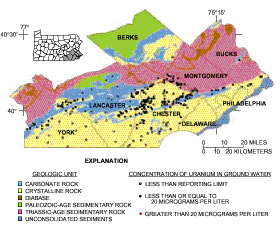 |
| Figure 1. Generalized geologic map and concentrations of dissolved uranium in the ground water in southeastern Pennsylvania. |
For the purpose of this report, the geologic units of southeastern Pennsylvania have been combined into six generalized geologic groups (fig. 1): carbonate rock (limestone, dolomite, and marble), crystalline rock (gneiss, phyllite, quartzite, and schist), diabase, Paleozoic-age sedimentary rock (conglomerate, limestone, sandstone, siltstone, and shale), Triassic-age sedimentary rock (conglomerate, sandstone, siltstone, and shale), and unconsolidated sediments (clay, sand, and gravel). No data for radionuclides in ground water are available for Paleozoic-age sedimentary rock or unconsolidated sediments. Because of the numerous analyses for radon-222, Sloto and Senior (1998) subdivided the crystalline rocks into four groups—gneiss, schist and phyllite, quartzite, and all other crystalline rocks.
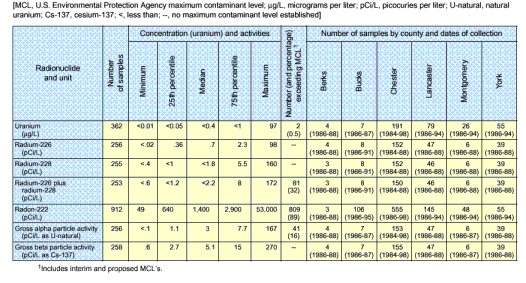 |
| Table 1. Statistical summary of results of analyses for radionuclides in ground water in southeastern Pennsylvania |
Uranium is the heaviest element in nature. Natural uranium consists of three isotopes: uranium-238, uranium-235, and uranium-234. The predominant isotope is uranium-238, which has a long half-life (4.5 billion years) and is relatively abundant in rocks and soils.
The U.S. Environmental Protection Agency (USEPA) has proposed a maximum contaminant level (MCL) of 20 µg/L (micrograms per liter)—which is equivalent to an activity of 30 pCi/L—for uranium in drinking water (U.S. Environmental Protection Agency, 1991). In this report, uranium concentrations are reported in micrograms per liter; 1 µg/L of uranium is equal to an activity of approximately 1.5 pCi/L when the isotopes of uranium-238 and uranium-234 are present in a 1:1 ratio.
In southeastern Pennsylvania, 362 ground-water samples were analyzed for uranium (fig. 1). The samples were collected from 167 wells in the Chickies Quartzite (46 percent of all wells sampled for uranium) and from 195 wells in other geologic formations. Concentrations ranged from less than 0.01 to 97 µg/L; 45 percent of the concentrations were below the reporting limit. Water samples from only two wells (0.6 percent of wells sampled) exceeded the proposed MCL. One sample was from a well in crystalline rock (53 mg/L), and one sample was from a well in carbonate rock (97 mg/L). Neither of the geologic units penetrated by these wells are known to have a high uranium content.
The most common isotopes of radium are radium-224, radium-226, and radium-228. Radium-226 is a decay product of uranium-238 and has a half-life of 1,600 years. Radium-228 is a decay product of thorium-232 and has a half-life of 5.8 years. Radium-224 also is a decay product of thorium-232 and has a short half-life of 3.6 days. Radium-226 and radium-224 decay by emitting an alpha particle, and radium-228 decays by emitting a beta particle. No water samples from southeastern Pennsylvania have been analyzed for radium-224 but studies in New Jersey (Szabo and others, 1998) have shown it to be present in ground water in elevated concentrations.
Radium in drinking water is known to increase cancer risk, primarily for bone and sinus cancer (Mays and others, 1985). The USEPA MCL for radioactivity in drinking water is set at a level of a 1 in 10,000 risk of a fatal cancer if 2 liters of water per day is consumed for 70 years. The MCL for total dissolved radium, which is defined as the sum of radium-226 and radium-228, is 5 pCi/L (U.S. Environmental Protection Agency, 1976). Radium is moderately soluble in water, and all isotopes of radium are equally soluble.
Water samples from 256 wells were analyzed for radium-226. The samples were collected from 168 wells in the Chickies Quartzite (66 percent of all wells sampled for radium-226) and from 88 wells in other geologic formations. Activities ranged from less than 0.02 to 98 pCi/L. The activity of radium-226 in water samples from 46 wells (18 percent of wells sampled) was below the reporting limit, which ranged from 0.02 to 1 pCi/L depending on the analytical technique used. The median activity was 0.7 pCi/L. Water samples from 30 wells in the Chickies Quartzite (18 percent of wells sampled in the Chickies Quartzite) and from 2 wells in other formations (2 percent of wells sampled in other formations) exceeded 5 pCi/L. One of those samples was from a well in quartzite (Setters Formation), and one was from a well in carbonate rock.
Water samples from 255 wells were analyzed for radium-228. The samples were collected from 169 wells in the Chickies Quartzite (66 percent of all wells sampled for radium-228) and from 86 wells in other geologic formations. Activities ranged from less than 0.4 to 160 pCi/L. Activities in samples from 177 wells (46 percent of wells sampled) were below the reporting limit, which ranged from 0.4 to 2 pCi/L. The median activity was less than 1.8 pCi/L (below the reporting limit). Water samples from 66 wells in the Chickies Quartzite (39 percent of wells sampled in the Chickies Quartzite) and from 2 wells in other geologic formations (2 percent of wells sampled in other formations) exceeded 5 pCi/L. One of those water samples was from a well in quartzite (Harpers Formation), and one was from a well in carbonate rock.
Water samples from 253 wells were analyzed for total radium (radium-226
plus radium-228) (fig. 2). The samples were collected from 169 wells in
the Chickies Quartzite (67 percent of all wells sampled for both radium-226
and radium-228) and from 84 wells in other geologic formations. Activities
ranged from less than 0.6 to 172 pCi/L. The activity of radium-228 in
water samples from 122 wells (48 percent of wells sampled) were below
the reporting limit, which ranged from 0.6 to 5.8 pCi/L. The median activity
was less than 2.2 pCi/L. Water samples from 78 wells in the Chickies Quartzite
(46 percent of wells sampled in the Chickies Quartzite) and 6 wells in
other geologic formations (7 percent of wells sampled in other formations)
exceeded the USEPA MCL of 5 pCi/L for total radium. Three of those samples
were from wells in quartzite (Harpers and Setters Formations), one from
a well in crystalline rock, and two from wells in carbonate rock.
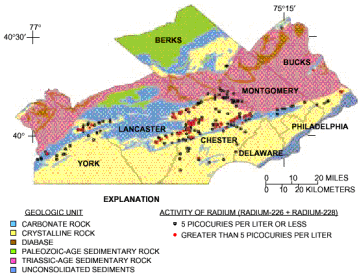 |
| Figure 2. Activities of dissolved radium-226 plus radium-228 in the ground water in southeastern Pennsylvania. |
Senior and Vogel (1995) found that the concentration of radium in water from the Chickies Quartzite is inversely related to pH but directly related to dissolved organic carbon, total dissolved solids, barium, and sulfate. The activities of radium in all water samples from the Chickies Quartzite with a pH less than 4.7 exceeded the USEPA MCL of 5 pCi/L (fig. 3). Low pH decreases the adsorption of radium onto the aquifer matrix and thus increases the amount of radium in ground water.
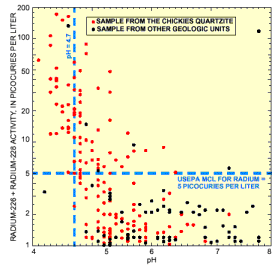 |
| Figure 3. Relation between the activity of total radium (radium-226 plus radium-228) and pH in samples of ground water from southeastern Pennsylvania. |
Radon is a colorless, odorless radioactive gas that is soluble in water. The most abundant isotope of radon is radon-222. It is produced through the radioactive decay of uranium-238 and radium-226, which are naturally present in rock and soil. Radon-222 has a half-life of 3.8 days. The Surgeon General of the United States has recognized exposure to radon gas as being second only to cigarette smoking as a cause of lung cancer (U.S. Environmental Protection Agency, 1992). Radon gas can cause lung cancer if inhaled because its decay products can accumulate in the lungs and damage tissue. Radon moves from its source in rocks and soils through voids and fractures. It can enter buildings as a gas through foundation cracks, or it can dissolve in ground water and be carried to buildings through the use of water-supply wells. The USEPA has proposed an MCL of 300 pCi/L for radon-222 in drinking water for water systems without an individual indoor air radon program and 4,000 pCi/L for water systems with an individual indoor air radon program (U.S. Environmental Protection Agency, 1999).
Water samples from 912 wells were analyzed for radon-222 activity (fig. 4). The samples were collected from 184 wells in the Chickies Quartzite (20 percent of all wells sampled for radon-222) and from 728 wells in other geologic formations. Activities ranged over four orders of magnitude—from 49 to 53,000 pCi/L. The median activity was 1,400 pCi/L. Radon-222 activities in water from 89 percent of sampled wells exceeded 300 pCi/L, and the activities in water from 16 percent of sampled wells exceeded 4,000 pCi/L (table 2).
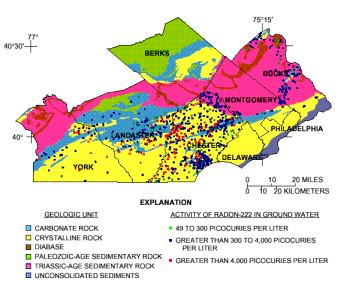 |
| Figure 4. Activities of dissolved radon in the ground water in southeastern Pennsylvania |
Radon-222 activity in ground water generally differs among rock types
and can vary considerably within the same geologic formation (table 3).
The geologic groups with the greatest median radon-222 activities in ground
water are schist (2,500 pCi/L) and quartzite (2,300 pCi/L).
Radon-222 activities in ground water vary with time because of factors
such as dilution by recharge, changes in contributing areas of the aquifer
due to pumping, or seasonal fluctuations in the water table. Data on temporal
variability of radon-222 in ground water is available for 29 wells in
Chester County that were sampled more than once. The maximum difference
in radon-222 activities in two samples collected from the same well was
5,100 pCi/L, and the median difference was 350 pCi/L (Senior, 1998). Radon-222
activities differed by more than 50 percent in water from 36 percent of
the wells sampled more than once and by more than 100 percent in water
from 18 percent of the wells sampled more than once. Of the 10 wells sampled
at regular intervals for at least 1 year, seasonal fluctuations in radon-222
activities were observed for only 1 well (fig. 5). For most wells, radon-222
activities did not exhibit a strong seasonal pattern of fluctuation and
were not consistently related to changes in depth to water.
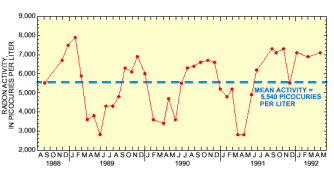 |
| Figure 5. Variabillity with time in the activity of radon-222 dissolved in water from a well in nothern Chester County, Pennsylvania |
Senior (1998) tested the statistical relations between radon-222 activities and well characteristics, such as depth or yield, and the relations between radon-222 activities and concentrations of other chemical constituents analyzed in water samples. As expected, radon-222 activities generally did not correlate with well characteristics, the pH of water, or concentrations of dissolved major ions and other chemical constituents in the water samples because radon-222 is an inert gas.
|
||||||||||||||||||||||||||||||||||||||||||||
Gross alpha particle activity is a measure of the total amount of radioactivity in a water sample attributable to the radioactive decay of alpha-emitting elements. Alpha particles are highly ionizing, but the particles travel short distances in air (less than 2 inches) before being absorbed. Alpha particles have little ability to penetrate objects; thus, they can be stopped by a sheet of paper or the outer layer of skin. The external hazard from alpha particles is minimal, but the internal hazard when they are inhaled or ingested may be significant.
Gross alpha particle activity is reported in picocuries per liter as natural uranium (pCi/L as U-natural). The observed radioactivity is compared with the activity of a natural uranium calibration standard, and the results are reported in terms of equivalent quantities of the reference standard. The USEPA MCL for gross alpha particle activity in drinking water is 15 pCi/L (U.S. Environmental Protection Agency, 1976). Because radium-226 is an alpha particle emitter, gross alpha particle activity may be used as a screening tool to predict the presence of radium-226 and radium-224 in a water sample. Radium-226 correlates strongly with gross alpha particle activity in samples of ground water from southeastern Pennsylvania (fig. 6).
Water samples from 256 wells were analyzed for gross alpha particle activity (fig. 7). The samples were collected from 170 wells in the Chickies Quartzite (66 percent of all wells sampled for gross alpha particle activity) and from 86 wells in other geologic formations. The time between sample collection and analysis generally exceeded 72 hours; therefore, the alpha particle activity contributed by the decay of radium-224 (half-life of 3.6 days) was not counted. A shorter time between sample collection and analysis than was used would include the alpha particle activity contributed by radium-224 and other short-lived alpha-emitting radionuclides and would result in higher gross alpha particle activities. Activities ranged from less than 0.1 to 167 pCi/L. The gross alpha particle activity of water samples from 67 wells (26 percent of wells sampled) was below the reporting limit, which ranged from 0.1 to 5 pCi/L. The median activity was 3 pCi/L. Water samples from 39 wells in the Chickies Quartzite (23 percent of wells sampled in the Chickies Quartzite) and 2 wells in other geologic formations (2 percent of wells sampled in other formations) exceeded the USEPA MCL of 15 pCi/L. One water sample was from a well in crystalline rock, and one was from a well in carbonate rock.
Gross beta particle activity is a measure of the total amount of radioactivity in a water sample attributable to the radioactive decay of beta-emitting elements. Beta particles usually travel greater distances in air than alpha particles (about 6 feet) before being absorbed. Beta particles are more penetrating than alpha particles, and some are capable of penetrating the skin and causing radiation damage. Beta particles present an external as well as an internal hazard from inhalation or absorption.
Gross beta particle activity is reported in picocuries per liter as cesium-137 (pCi/L as Cs-137). The observed radioactivity is compared with the activity of a cesium-137 calibration standard, and the results are reported in terms of equivalent quantities of the reference standard. The USEPA MCL for gross beta particle activity states that the average annual concentration of beta particle activity from radionuclides in drinking water shall not produce an annual dose equivalent to the total body or any internal organ greater than 4 millirems per year (U.S. Environmental Protection Agency, 1976). A large number of naturally occurring and man-made radionuclides emit beta particles; therefore, the presence of elevated gross beta activities requires extensive testing for individual radionuclides (Lappenbusch and Cothern, 1985).
Water samples from 258 wells were analyzed for gross beta particle activity reported in terms of cesium-137 (fig. 8). Water samples were collected from 171 wells in the Chickies Quartzite (66 percent of all wells sampled for gross beta particle activity) and from 87 wells in other geologic formations. Activities ranged from 0.6 to 270 pCi/L. The gross beta particle activity of water samples from only four wells (2 percent of wells sampled) was below the reporting limit, which ranged from 1 to 4 pCi/L. The median activity was 5.1 pCi/L. Water samples from 56 wells in the Chickies Quartzite (33 percent of wells sampled in the Chickies Quartzite) and 6 wells in other geologic formations (7 percent of wells sampled in other formations) exceeded 15 pCi/L, the activity at which the USEPA requires testing for selected individual beta-emitting radionuclides (Lappenbusch and Cothern, 1985). One of those water samples was from a well in quartzite (Hardyston Formation), three were from wells in crystalline rock, and one was from a well in carbonate rock.
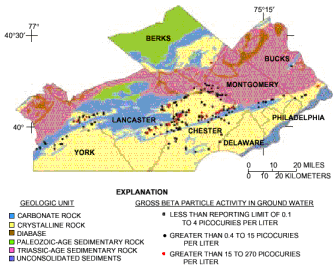 |
| Figure 8. Gross beta particle activity in the ground water of southeastern Pennsylvania. |
Radioactivity, especially the presence of the known human carcinogen, radium, in drinking water in southeastern Pennsylvania may pose a health problem, especially for residents drinking water from wells drilled in the Chickies Quartzite. Total radium (radium-226 plus radium-228) activities exceeded the USEPA MCL of 5 pCi/L in water from 46 percent of wells sampled in the Chickies Quartzite and 7 percent of wells sampled in other formations. All water samples from the Chickies Quartzite with a pH less than 4.7 exceeded the MCL for total radium.
Homeowners using wells drilled in the Chickies Quartzite may choose to have their water tested for the presence of radium, especially if the pH is less than 4.7. Because gross alpha particle activity is strongly correlated with radium-226 (Senior and Vogel, 1995), it is a good screening tool for the presence of radium-226 and radium-224 but not radium-228, which is a beta emitter. Gross alpha particle activities in water from 52 percent of wells sampled in the Chickies Quartzite exceeded 5 pCi/L, slightly higher than the percentage of wells exceeding the MCL for radium, indicating that there are not a large number of “false positive” results by utilizing the simpler gross alpha particle test. Analysis for gross alpha particle activity is less expensive than analysis for radium, and a homeowner whose well produces water with a gross alpha particle activity greater than 15 pCi/L may choose to treat their water for radium. Radium can be removed from a household water supply with an ion exchange water softener (Zapecza and Szabo, 1988; Lucas, 1987).
Radon-222 may pose a health problem for homeowners by contributing to indoor air radon-222 levels. The median radon-222 activity in water samples from 912 wells was 1,400 pCi/L. The radon-222 activity of water from 89 percent of sampled wells exceeded 300 pCi/L, and water from 16 percent of sampled wells exceeded 4,000 pCi/L, the proposed USEPA MCL’s. Radon-222 activity in ground water generally differs among rock types and can vary considerably within the same geologic formation. The geologic groups with greatest median radon-222 activities in ground water are schist (2,500 pCi/L) and quartzite (2,300 pCi/L). The Chester County Water Resources Authority and Chester County Health Department (1999) present a strategy for remedial action for elevated activities of radon-222 in ground water and present several remediation options, which include (1) installing an aeration device in the water system, (2) connecting to public water, (3) installing a granulated activated charcoal filter, or (4) drilling a new well.
Uranium does not appear to be present in elevated concentrations in ground water in southeastern Pennsylvania. Water samples from only 2 of 362 wells sampled (0.6 percent) exceeded the proposed USEPA MCL for uranium. Concentrations of uranium in water samples from 45 percent of the wells sampled were below reporting limits. Methods for removal of uranium from a water supply are summarized by Zapecza and Szabo (1988).
Bird, P.H., 1998, Geohydrology and ground-water quality of Warwick Township, Bucks County, Pennsylvania: U.S. Geological Survey Water-Resources Investigations Report 97-4267, 37 p.
Chester County Water Resources Authority and Chester County Health Department, 1999, Radioactivity and ground water: What you should know—A guide for residential home owners: West Chester, Pa., 21 p. (can be viewed at http://www.chesco.org/water/wra_radon.html)
Lappenbusch, W.L., and Cothern, C.R., 1985, Regulatory development of the interim and revised regulations for radioactivity in drinking water—past and present issues and problems: Health Physics, v. 48, no. 5, p. 535-551.
Lindsey, B.D., and Ator, S.W., 1996, Radon in ground water of the Lower Susquehanna and Potomac River Basins: U.S. Geological Survey Water-Resources Investigations Report 96-4156, 6 p.
Lucas, H.F., 1987, Radium removal by a home water softener: Journal of Environmental Radioactivity, v. 5, p. 359-362.
Mays, C.W., Rowland, R.E., and Steheny, A.F., 1985, Cancer risk from the lifetime intake of Ra and U isotopes: Health Physics, v. 48, p. 635-647.
Senior, L.A., 1996, Ground-water quality and its relation to hydrogeology,
land use, and surface-water quality in the Red Clay Creek Basin, Piedmont
Physiographic Province, Pennsylvania and Delaware: U.S. Geological Survey
Water-Resources
Investigations Report 96-4288, 122 p.
_____1998, Radon-222 in the ground water of Chester County, Pennsylvania:
U.S. Geological Survey Water-Resources Investigations Report 98-4169,
79 p.
Senior, L.A., and Vogel, K.L., 1995, Radium and radon in ground water in the Chickies quartzite, southeastern Pennsylvania: U.S. Geological Survey Water-Resources Investigations Report 92-4088, 145 p.
Senior, L.A., Sloto, R.A., and Reif, A.G., 1997, Hydrogeology and water quality of the West Valley Creek Basin, Chester County, Pennsylvania: U.S. Geological Survey Water-Resources Investigations Report 94-4137, 160 p.
Sloto, R.A., 1994, Geology, hydrology, and ground-water quality of Chester County, Pennsylvania: West Chester, Pa., Chester County Water Resources Authority Water-Resource Report 2, 127 p.
Sloto, R.A., Macchiaroli, Paola, and Towle, M.T., 1996, Geohydrology of the Stockton Formation and cross-contamination through open boreholes, Hatboro Borough and Warminster Township, Pennsylvania: U.S. Geological Survey Water-Resources Investigations Report 96-4047, 49 p.
Sloto, R.A., and McManus, B.C., 1996, Hydrogeology and ground-water quality of Valley Forge National Historical Park, Montgomery County, Pennsylvania: U.S. Geological Survey Water-Resources Investigations Report 94-4109, 85 p.
Sloto, R.A., and Schreffler, C.L., 1994, Geohydrology and ground-water quality of northern Bucks County, Pennsylvania: U.S. Geological Survey Water-Resources Investigations Report 94-4109, 85 p.
Sloto, R.A., and Senior, L.A., 1998, Radon in the ground water of Chester County, Pennsylvania: U.S. Geological Survey Fact Sheet 120-98, 4 p.
Szabo, Zoltan, DePaul, V.T., and Parsa, Bahman, 1998, Decrease in gross alpha-particle activity in water samples with time after collection from the Kirkwood-Cohansey aquifer system in southern New Jersey: implications for safe drinking water regulations [Abstract]: 63rd Annual Meeting, New Jersey Section of America Water Works Association, Atlantic City, New Jersey.
U.S. Environmental Protection Agency, 1976, Interim primary drinking water regulations - promulgation of regulations on radionuclides: Federal Register, v. 41, July 9, 1976, Part II, p. 28,402-29,409.
_____1991, Primary drinking water regulations, Radio-nuclides, proposed rules: Federal Register, v. 56, July 18, 1991, p. 33,050.
_____1992, Consumers Guide to Radon Reduction - How to reduce radon levels in your home: EPA 402-K92-003, 17 p.
_____1999, National primary drinking water regulation, Radon-222, proposed rule: Federal Register, v. 64, no. 211, November 2, 1999, p. 59,245-59,294.
Zapecza, O.S., and Szabo, Zoltan, 1988, Radioactivity in ground water—a review: U.S. Geological Survey Water-Supply Paper 2325, p. 50-57.